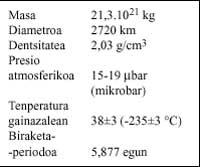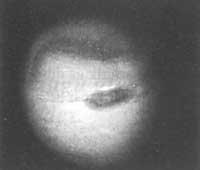Triton (I)
If in the previous issue we said that Neptune had presented many surprises and incomprehensible problems, now we can say the same thing about Triton. Moreover, this Neptune satellite has been the protagonist of the last phase of the Voyager-2 journey. Due to the peculiarities of its characteristics, Triton attracted the attention of the researchers since the first photos arrived on Earth, also despising Neptune to a background.

Before approaching Voyager 2 to Triton, a characteristic that distinguishes this satellite from all the rest of the Solar System was known: the retrograde direction of the translation movement. That is, Neptune's rotation movement on its axis and Triton's translation directions around Neptune are opposite. In addition, the route of Triton is not in the plane of the equator of Neptune. These two particularities led to conjectures about the origin of Triton.
Astronomers had questioned that Triton's creation process was like that of other Solar System satellites. However, these particularities were not enough to change the preliminary image of this satellite. That's why they were surprised when the Voyager 2 cameras, instead of a completely icy and slow look, showed a young surface and very different geological circumstances. On the other hand, a weak magnetic field and a thin atmosphere have been detected.
The following table shows the physical characteristics of the Tritons that have been measured. As can be seen, Triton is a little smaller than the Moon and as far as its size and density can be said that Pluto is very similar. Apparently, Triton is made up of a mixture of rock and ice, and not just ice, as some astronomers thought. The interior ice would be mostly water, although in the vicinity of the surface is more abundant the nitrogen.

The atmosphere resembles that of Titanium. Along with this satellite and the Earth of Saturn, they are the only ones with nitrogen as their main component. The other component is methane, but there is very little. Of course, the height of the atmosphere is low, but it is at least 800 km. Layers of fog and cloud have also been observed up to an approximate height of 25 km. Supposedly these clouds are formed by methane frosts or particles of aerosols or hydrocarbons produced by the interaction of this gas with sunlight. Winds blow in the southern hemisphere (when it has been better studied) northeast around the surface and west at the top. Estimates of the speed of the first have also been made, resulting in about 5 m/s.
The next characteristic of the table is temperature. Its value is below the freezing point of nitrogen. Therefore, Voyager 2 taught us three quarters of the southern hemisphere covered with nitrogen snow. In this hemisphere it is the last part of spring. All signs indicate that Triton is colder than Pluto himself.
The following issue will address the geological incidents of Triton and the organic compounds detected on the surface. Below we will talk about the latest ideas about their origin, as they are related to the process of formation of the atmosphere and these geological incidents.

According to all experts, Neptune was formed from the acration of gases and small bodies (such as Jupiter and Saturn) at a time when the solar system was emerging, some 4.5 billion years ago. However, their system of satellites and rings, that is, the residues of the formation process, should be more numerous. This waste shortage could be due to Triton. According to this hypothesis, in principle Triton would have had its orbit around the Sun, but by colliding with some moon of Neptune or this planet could attract its system.
The shock would explain the peculiarities of the Triton translation movement mentioned above, and the new satellite would also be responsible for the relative “cleanliness” of the Neptune environment. At first Triton could have a very eccentric orbit, but the tidal force generated by the planet would have a double effect, on the one hand the circularization of the orbit and on the other the internal warming of Triton due to the friction forces generated by the tides. This internal energy would transform the geologically active surface.
Moving this hypothesis to the final conclusions, the atmosphere would be due to internal gas emissions. That is, the creation and loss of the atmosphere in Triton would occur as in the comets (This process was studied by the probe Giotto when he approached the Halley Kometa). Therefore, it could be the body created in the Cloud of Triton Oort, the giant kite.
As already mentioned, the next issue will analyze other particularities of this interesting star.
|





